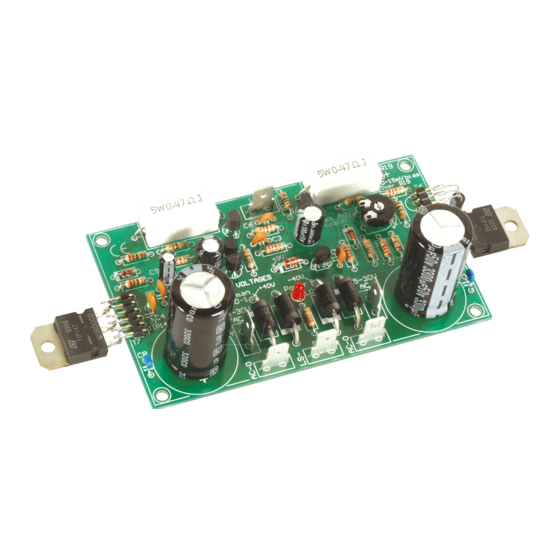
Summary of Contents for Velleman K8060
- Page 1 Total solder points: 74 Difficulty level: beginner 1 advanced 200W DISCRETE POWER AMPLIFIER K8060 ILLUSTRATED ASSEMBLY MANUAL H8060IP-1...
- Page 2 Features & Specifications Specifications: Excellent value for money Full discrete design using Epitaxial Darlington transistors DC supply circuit on board with LED indication Ideal for active speaker system or sub woofer, guitar amp, home theatre systems, instruments amp…. Comes complete with transistor isolators, spacers and bolts Overload and short circuit protection Features: 200W music power @ 4 ohm load...
- Page 3 Assembly hints 1. Assembly (Skipping this can lead to troubles ! ) Ok, so we have your attention. These hints will help you to make this project successful. Read them carefully. 1.1 Make sure you have the right tools: • A good quality soldering iron (25-40W) with a small tip.
- Page 4 Assembly hints 1.3 Soldering Hints : 1- Mount the component against the PCB surface and carefully solder the leads 2- Make sure the solder joints are cone-shaped and shiny 3- Trim excess leads as close as possible to the solder joint REMOVE THEM FROM THE TAPE ONE AT A TIME ! AXIAL COMPONENTS ARE TAPED IN THE COR- RECT MOUNTING SEQUENCE !
- Page 5 Construction 1. Diodes. Watch the polarity ! 4. Transistor connections R3 : 3K3 (3 - 3 - 2 - B) R4 : 330 (3 - 3 - 1 - B) R5 : 220 (2 - 2 - 1 - B) D1 : 1N4148 R6 : 47 (4 - 7 - 0 - B)
- Page 6 Construction & connection 7. Trim potentiometer 5. Power diodes. 10. PCB tabs. Watch the polarity ! RV1 : 1K D3 : 1N5404 D4 : 1N5404 D5 : 1N5404 D... D6 : 1N5404 CATHODE 11. Electrolytic Capacitors. Watch the polarity ! +/-5mm 8.
- Page 7 Construction 13. 5W resistors R... R19 : 0,47 R20 : 0,47 IMPORTANT 14. Electrolytic Capacitors. Watch the polarity ! Check the complete assembly carefully before mounting the heat sink. C12 : 3300µF C13 : 3300µF Once the heat sink is mounted, the solder-side is no longer accessible.
- Page 8 Final Assembly 15. Final assembly A custom pre-drilled heat sink is available from your distributor (order code HSVM100). Any other heat sink must be able to dissipate at least 30W (1.25°C/W) (see fig.1.0). Use the template as a drill guide Fig.
- Page 9 Final assembly • • Mount 4 bolts + 8 nuts (PCB support). (fig.2.0) Slide the PCB over the 4 bolts, and fix using 4 nuts (Fig 3.0). 2 x M3 nut Fig. 3.0 M3 15mm bolt Fig. 2.0...
- Page 10 Transistor T6 16. Mounting the transistor T6 on the heat sink: • Apply a drop of heat conductive compound in the heat sink hole (fig. 4.0). Fig. 4.0...
- Page 11 Transistor T6 • Insert the transistor (BC547) in the hole (Fig. 5.0). Pay attention to the position of the transistor (fig 6.0)! BC547 Fig. 5.0 Fig. 6.0 • Carefully bend the leads and solder them to the connector T6, see figure 7.0.
- Page 12 Power transistors 17. Mounting of the power transistors T7 (TIP147) and T8 (TIP142). M3 nut • Lock washer Apply a drop of heat conductive compound on the heat sink (see fig 8.0.) washer • plastic isolation Mount the isolation mica onto the heat sink, check the position of the hole. washer Apply a drop of heat conductive compound on the mica.
- Page 13 Power transistors • Solder the connections of the power transistors with the pin headers, see fig. 10. Fig. 10...
- Page 14 Use a 2 x 25 to 30Vac / 100 - 120VA transformer. • Connect the transformer to the AC power connections of the PCB. • The Velleman transformer colour scheme is specified on the pcb. Careful : Other brands may feature a different scheme ! SOLDER Y: yellow, R: red, B: blue, G: grey.
- Page 15 Test & adjustments 1A T (slow-blow) fuse 2 x 25 to 30Vac transformer mains VOLUME CONTROL 47K Log. 4 - 8 Ohm optional Inputsignal...
- Page 16 Test & adjustments • Turn the RV1 bias adjust trimmer fully counter clockwise (turn left) before applying power for the first time. ADVICE: For safe first-time testing insert a 60W light bulb in series with the AC power and the trans- former.
- Page 17 Test & adjustments Final connection: • The input (GND and in) can be connected directly to an audio source (pre-amp or mixing panel) or a vol- ume control (potentiometer) can be used (see diagram). • Connect the speaker (4 ohm or higher) to the connections LS+ and GND. CAUTION: VOLTAGES OF ABOUT 80V ARE PRESENT.
- Page 18 19. PCB layout.
- Page 19 Bias current (cold) BC547 10-15mV over R19 220R 0.47 / 5W ZB9V1 100µ/50V 500R BC547 Bias adj. 0.47 / 5W 47nF BC640 BC640 BC557 10µF 220R TIP147 680R 1N4148 -40V 330R 470µ/16V 100R BC639 680p -40V -40V Title K8060 100W amplifier...
- Page 20 VELLEMAN Components NV Legen Heirweg 33 9890 Gavere Belgium Europe www.velleman.be www.velleman-kit.com Modifications and typographical errors reserved © Velleman Components nv. H8060IP - 2005 - ED1 5 4 1 0 3 2 9 3 3 5 0 7 6...

















Need help?
Do you have a question about the K8060 and is the answer not in the manual?
Questions and answers